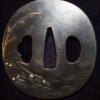Hi Mariusz,
This is a constant source of concern for me, too. I keep my blades and koshirae in a glass/wood cabinet, with a tight lid and consequently very slow moisture exchange with the ambient air. The moisture has to penetrate slowly through solid birch sidewalls, or through the plywood bottom. During the cold and dry season, I regularly insert a 30 cm lenght of clean wood that has been stored outside in a shed and thus has something like 30 mass-% of water in it. This piece of wood slowly evaporates moisture into the air inside the cabinet, and keeps the moisture at a tolerable level. I would hesitate to insert liquid water into the cabinet. The moisture will rise too much/too rapidly, and in the liquid itself there is a possibility of mold growth.
Recently I decided to leave one of my shinsa-destined blades behind when travelling to Tampa Shinsa, because the blade has koshirae only, and the rapid moisture change from 1% to 80% would probably have damaged the saya.
Despite of these measures, I prefer buying blades in shirasaya instead of high-quality lacquered koshirae.
Veli





